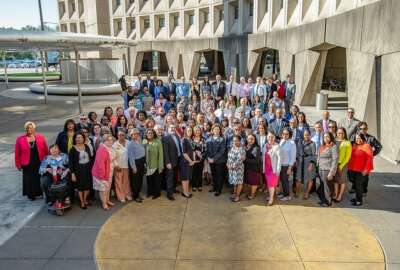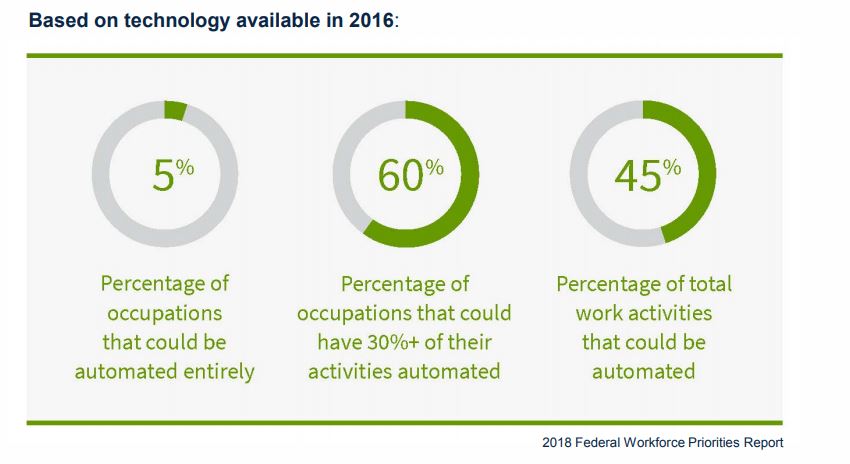
Desire for pay demonstration, job training highlight OMB workforce summit
The Office of Management and Budget’s day-long event Sept. 12 with public and private sector leaders will produce a set of recommendations for how to transform...
Best listening experience is on Chrome, Firefox or Safari. Subscribe to Federal Drive’s daily audio interviews on Apple Podcasts or PodcastOne.
When it comes to the Trump administration’s priority to reskill or upskill the federal workforce, the best place to start in understanding the uphill challenge is with the numbers.
A Federal News Radio special report in May found more than 45 percent of the federal workforce is more than 50 years old and 25 percent of them are more than 55 years old. Conversely, just six percent of feds are under 30 years old.
But numbers, as is usually the case, don’t tell the entire story.
Nearly every job in the public and private sectors tries to answer the continuous question of how to evolve as new technology impacts the routine and complex parts of your day.
Basically what this means is agencies — and let me emphasize the private sector as well — have hundreds of thousands of employees who will need new skills or will need to change the way they do work over the next three to five years.
“Our data analysis found that 1.3 billion out of 4.3 billion hours could be freed up in the federal workforce by automating manual tasks. That is a lot of potential hours that could be moved from lower value to higher value activities,” said Bill Eggers, the director of public sector research for Deloitte Service. “A good portion of these higher value activities might require a certain amount of reskilling/upskilling. If you assume about 2,087 hours worked per federal employee annually, then you see a large number of employees (in the hundreds of thousands) could eventually require some updating of their skills as they move to higher value activities and under-resourced jobs like cybersecurity and data science. But that’s no different than nearly every organization, public or private, as we enter this new age of work.”
In the President’s Management Agenda, the administration estimates based on 2016 data that 45 percent of all work could be automated and 5 percent of all occupations could be automated entirely.

Now the reason why this workforce discussion is coming up today is the Office of Management and Budget had another one of their “secret” no press allowed events — well, except for one member of the media who moderated a panel in the morning, but that’s for a different story — where they wanted to discuss potential solutions to this ongoing workforce challenge.
Unlike the no-press-allowed event held a few weeks ago around the Technology Modernization Fund, OMB, to their credit, provided some details and background on the discussion points.
An OMB spokesman said the symposium brought in “leading industry experts from around the country to participate in a day-long working session to share best practices and identify concrete next steps for action. Leveraging representatives from diverse organizations with deep, cross-functional expertise in human resource issues, we hope to gain policy ideas and also identify capabilities to help modernize a Federal Workforce for the 21st Century.”
But I decided to go a bit further and talk to people who actually attended the morning and afternoon sessions. All participants spoke on the condition of anonymity because OMB asked the event be “on background.”
OMB held nonpartisan discussions
Overall, the five people I spoke with all were complementary and enthusiastic about the sessions. All said the tenor and tone of the conversations were nonpartisan and focused on learning and sharing. The day-long event seemed also to be part of OMB’s preparation to launch the Government Effectiveness Advanced Research (GEAR) Center in 2019.
“Everyone is dealing with [the] same challenges around their workforces. There is a lot of anxiety in the workforce around artificial intelligence and robotics so how do we engage employees in that process so they don’t have a negative reaction to the technology?” said one industry source. “How can we partner with them to better understand how to make work more productive? They want to move up value change and technology can help, but if they are not engaged in the process, there is a risk that they may not adopt and embrace the technology like they should.”
Another industry official added the emerging technologies, employee expectations and cost pressures are driving these changes.
“There is so much the government needs to do especially when you consider the size of federal workforce has remained constant or has been declining over the last few decades while the size of the government in terms of what it does has grown significantly,” said the official. “In order to enable government workers to address their mission imperatives, technology can help in a constrained workforce environment to free up time. That’s where reskilling and upskilling comes up, and that was much more the tenor of discussion.”
 OMB brought in speakers from Willis Towers Watson, a global advisory firm focusing on risk management and human resources, the International Brotherhood of Electrical Workers (IBEW), Amazon Web Services and even someone from California Governor Jerry Brown’s office, according to the day’s agenda obtained by Federal News Radio and attendees who spoke to us.
OMB brought in speakers from Willis Towers Watson, a global advisory firm focusing on risk management and human resources, the International Brotherhood of Electrical Workers (IBEW), Amazon Web Services and even someone from California Governor Jerry Brown’s office, according to the day’s agenda obtained by Federal News Radio and attendees who spoke to us.
What seemed to be missing, besides the press, were the federal employee unions. We know the relationship between the administration, the American Federation of Government Employees, the National Treasury Employees Union, the National Federation of Federal Employees and others is not good. But these changes will not happen unless the administration works closely with the employees unions. That may have been one part of the day which OMB overlooked.
The morning sessions were mostly one-way discussions with the assorted panelists laying out the challenges and/or describing some ongoing industry efforts to address workforce challenges, participants said.
The afternoon breakout sessions were much more interactive and focused on three main areas: Reskilling the workforce, talent management, and performance and compensation. Participants said OMB expects to issue a report from the event in a few months.
“One good takeaway from the private sector was around the performance appraisal process and the need to separate it from the feedback process,” said another industry source. “Right now, the government does both once or twice a year. But the industry speakers said there is need to separate the feedback and make it an ongoing and regular part of the discussions. By doing the feedback and appraisal at same time, it doesn’t do justice for the organization.”
Federal pay flexibility exists
Another key takeaway was the flexibility agencies have around compensation, the industry source said.
“Once you realize the limitations of the Title V structure, there are more interesting things that you can do, like pay demonstrations,” the source said. “When was last time OPM approved a pay demonstration? It was probably 15 years ago. So promoting more experimentation in that space was discussed. If you have the authority, why not use it?”
Another participant said part of the discussion reskilling or upskilling employees focused on balancing all the different needs of the workforce, the taxpayer and the administration.
“This is a really important conversation,” the source said. “There is a lot of sensitivities around the perception that this all will lead to a reduction in force (RIFs). This is a good topic to talk about and not one previous administrations gave a lot of attention too. I was impressed by the questions [OMB deputy director for management] Margaret Wiechert and [OPM Director] Jeff Pon are asking.”
Around performance management, the source said several previous administrations unsuccessfully tried to address this issue.
“One of the more interesting inputs from the commercial sector was instead of using the typical federal employee rating structure where you are too focused on the rating of 1-to-5, maybe a better way would be to use pass/fail. Then, you can discuss things the employee is doing well or things they need to improve on,” said the source. “You also can communicate early in a person’s career if people are on a leadership track, what it looks like and what performance characteristics they should strive for. There were a lot of questions around the grading system and what are the pros and cons of it.”
Another participant said during the breakout session, the group recognized agencies don’t have credible performance management data, which makes it harder to address workforce issues because performance management is linked directly to having a talent management and not a compensation strategy.
“It was a healthy conversation especially since all sectors are going through this at the same time,” the participant said. “The government doesn’t know some of that basic workforce information so jumping to reskill hundreds of thousands of people comes back to what skills are needed. You have to understand the plans and strategies for how to make progress on objectives and goals before you can decide what you are changing.”
Read more of the Reporter’s Notebook
Copyright © 2025 Federal News Network. All rights reserved. This website is not intended for users located within the European Economic Area.
Jason Miller is executive editor of Federal News Network and directs news coverage on the people, policy and programs of the federal government.
Follow @jmillerWFED
Related Stories




